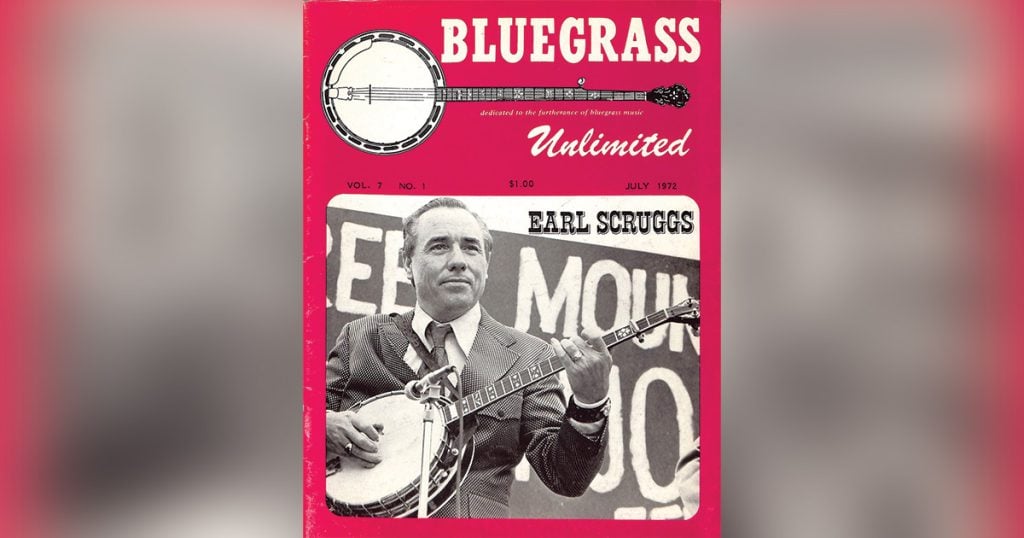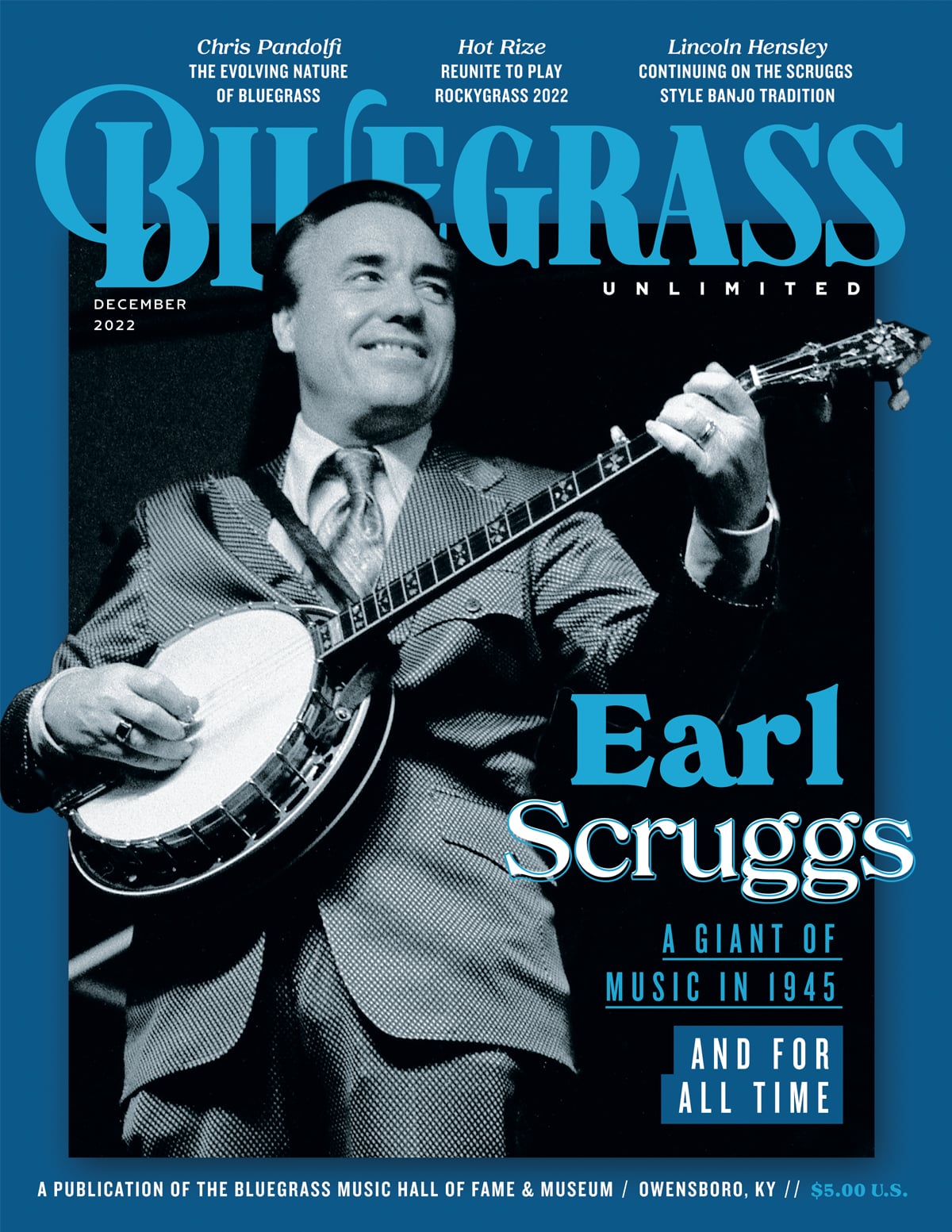Home > Articles > The Archives > The Earl Scruggs Goodtime Hour
The Earl Scruggs Goodtime Hour
Reprinted from Bluegrass Unlimited Magazine
February 1971, Volume 5, Number 8
This week we provide two perspectives on the documentary film about Earl Scruggs, with his family and friends, that aired on PBS in 1971. One review was printed in our February 1971 issue and the other (as a response to the first) was printed in our April 1971 issue (the BU cover photo used here appeared on our July 1972 issue when we featured a review of another film – Bluegrass Country Soul). After reading these two perspectives, you may want to check out the film. It is currently available on YouTube (click here).
One of the greatest innovators in American music was presented to America via many local Public TV outlets, with virtually no hint that he is a musical figure of consequence. The program lasted an hour and a half and was called “Earl Scruggs and his Friends’. The latter included Bill Monroe, the Morris Brothers, Doc Watson, Joan Baez, Bob Dylan and a Moog synthesizer. And featured more than prominently were Earl’s sons Randy and Gary, who managed to accompany virtually everyone presented.
Dylan was first, contributing to nice, unpretentious performances of “East Virginia Blues” and his “Nashville Skyline Rag”. Next we saw Earl singing harmony and playing with the Byrds. It was an o.k. workout but it certainly failed to show that grass musicians have anything significant to contribute to rock, even Nashville-style rock. Next we saw Earl in a studio listening to a servant of the new music technology give a rudimentary explanation of the synthesizer which then played the fiddle part to“Foggy Mountain Breakdown”. It too shows little promise for bluegrass – all those lights and wires and it couldn’t even substitute for a country fiddle.
Doc Watson followed, and the music he made with Earl (and Randy and Gary) provided the most memorable moments of the program, Doc was relaxed and jaunty as he is on stage and it was obvious that the two musicians hold each other in great esteem. Next came the wonderful Morris Brothers, Zeke and Wiley. Their career extends back to the old Mainer days. Earl worked with them even before he went to Nashville to join Bill Monroe. As important as the Morrises were to his career it was a shame to hear only two songs and a little desultory conversation.
From the countryside settings of the Watson and Morris sequences we were whisked back to a big studio to observe Randy and Gary (again) prepare a rock album for Vanguard — Earl was there too. We got to watch them overdub and record. They did that fine old country standard “Just a little help from my friends”. After recordings of that song by the Beatles and Joe Cocker there remains little to be done with it, which is what the junior Scrugges did. There was a corpulent, gum-chewing clown whose name I missed who gave a long spiel about Earl and banjos and “new directions”. The credibility gap widened rather large when he said uncuously that “Prior to Earl Scruggs the banjo was used for rhythm – it was the instrument of a clown’’. I wonder how Wade Ward, Pete Seeger, Uncle Dave Macon and a few others who preceded Earl would respond to that. With this dude the proceedings moved slowly downhill. There were a couple of minutes with Monroe and band, most poorly recorded in a parking lot. One might protest again that a man of such importance was given such short shrift. He did a good bit more for Earl than just pay his salary for a couple of years but you wouldn’t have known it.
Next we saw Randy, coming on like a future superstar. We saw him at school, at home and a number of other places too. He can pick nice Watson style guitar and shows promise of being a good musician someday. But until he has fulfilled some of that promise it seems unwise to overexpose him on records and TV. After all, who wants to be another Nancy Sinatra? Along with Gary we saw him and Earl again on an Opry sequence and for far too long at the home of Joan Baez. Miss Baez sings well and is a charming personality but Earl Scruggs has about as much in common with her as he does with Bill Anderson. Earl was off-screen most of the time Joan sang but we sure did get lots of Randy and Gary.
Most astonishing was the absence of Lester Flatt. Even his name was never mentioned – which makes it difficult to give any sort of rational presentation of Earl Scruggs’ career.
Earl Scruggs and Friends From Another Side
By Richard D. Smith
Reprinted from Bluegrass Unlimited Magazine
April 1971, Volume 5, Number 10
I must write in enthusiastic defense of the Public Broadcast documentary on “Earl Scruggs and Friends” that Dick Spottswood panned in BU. As both an amateur bluegrass musician and amateur filmmaker, I was really captivated by the warmth, humor, insight and technical competence of the film. I think it is important to bear in mind the short spoken introduction of the film’s creators- they simply stated that this man, Earl Scruggs, was a great musician who is going through a period of great change in his life which affects everything, especially his music. If one lets that statement slip by, then the rest of the show does not come into perspective, and might be justly criticized as having too little in the wrong places.
As Scruggs himself repeated several times in the film, he deeply enjoys the old tunes but not over and over again. What Scruggs (and sons) are up to now cannot, and I think should not, be judged by bluegrass standards. It is the new music that Earl is interested in developing for himself, something that is vital and immediate. Musicians like Earl constantly strive to change and grow, and if this means they will go afield from the more traditional, then we must let them go without misunderstanding. What if Bill Monroe had stayed with Charlie and played nothing but old mountain ballads all these years? Think of what the world would have missed.
From this perspective, I thought the sessions with the Byrds and with the Moog synthesizer were fun, and most of all they were tasteful – as Scruggs said in the film, he wants to keep going in new directions with the banjo, just so long as it fits. That’s an important criteria and I’m glad to hear Earl say that.
There certainly were disappointments in the film – now that Earl and Bill Monroe are on speaking terms again (remember how they refused to look at each other when they passed on the stage bridge at Warrenton in 1966), it is a shame that there was only a hurried medley of songs in Bill’s dressing room at the Opry. Flatt’s absence was glaring, but as the footage was shot so soon after the Foggy Mountain partnership broke up, we might write that off to personal friction that one day will be smoothed over. I agree with Mr. Spottswood about that fat, gum chewing record producer, but the man is deep in that crazy “show-biz” world, so some forgiveness may be due for his strange ways.
In general, the producers of this film were skilled in manipulation of sound and image. Their filming and recording of jam sessions, especially with Doc Watson, are to be commended. How many times have you heard a musician doing fabulous riffs, while the cameraman ignorantly pans in on his picking hand and completely ignores the fret work? We were spared this on the Scruggs special. Bear in mind also the limits of such a cinematic undertaking. Though not much time was spent with the Morris Brothers, the images, editing and context of their appearance led to a greater understanding of their career and their lives than was contained in their words alone. This is the power of film; we get more than just what we see and hear.
Now this is only speculation on my part, but I think the absence of mention of Earl’s participation at the 1969 Washington anti-war Moratorium was significant. I guess many fans feel that Earl is not only selling out in his music, but in his life as well. I do not think so.
My acquaintance with Flatt & Scruggs started only during my high school days. But when I saw them in person I was often saddened by how sickly and uncomfortable the great Earl Scruggs looked. It seemed as if he was losing hold both physically and spiritually. But when he came on stage at Bean Blossom last summer with his sons, I was immediately struck by how healthy and self confident he appeared. As he stood at a microphone stage center, he still exhibited that shyness so typical of the man, but appeared to have a new enjoyment and involvement with his performing.
I got this impression in the film too. I think Scruggs is genuinely working at what he wants to do, and although it is not bluegrass, it will have the master’s touch.
I hope you will be able to print my comments, because I enjoyed the film – and because I enjoy the wonderful music of Earl Scruggs (and of sons – I like Gary’s singing and I think Randy’s guitar work is the best fusion of Watson-type flat picking and rock-blues that has come along yet. In fact, he is developing his guitar work in the same way I imagine Bill Monroe must have once developed his unique mandolin playing. As another aside, I think the scenes in Randy’s Madison High School were both pathetic and hilarious).

